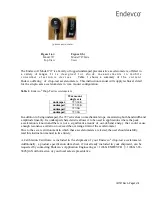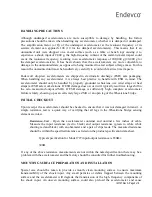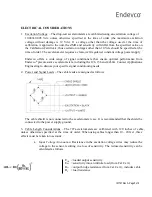
IM727 Rev A, Page 7 of 9
®
OPERATING PRECAUTIONS
While these drop-test accelerometers can be extremely rugged, they can also be extremely fragile
under very specific operating conditions, namely under resonance excitation. Due to the extremely
high levels of shock encountered and the potential for resonance excitation, the user should
read
this section carefully
before operating.
RESONANT FREQUENCY EXCITATION
The 727 series utilizes an undamped sensing element which means its resonant frequency is excited
more easily as compared to a damped device. Additionally, the 727 series does not incorporate any
mechanical overtravel stops, which means the displacement of the proof mass is not restricted. Since
the amplification factor for an undamped accelerometer can be up to 100, if there is sufficiently high
frequency content in the shock event, the excessive amplitude of the seismic mass can be well over
the overrange capability and cause permanent damage to the accelerometer.
Another thing to note is that each seismic element used on the 727 series includes two masses, each
with its own resonant frequency. If both resonant frequencies are excited, a beat frequency may
appear in your data that will be at a frequency equivalent to the difference between the two resonant
frequencies. Although the beat frequency will be apparent in the time history it will not translate to
the Fourier transform. Although resonance excitation cannot always be avoided, it possible for the
user to take measures to reduce the amount of high-frequency energy the accelerometer will be
subjected to.
BANDWIDTH AND AMPLITUDE LINEARITY
Because the 727 series is undamped and does not use mechanical over travel stops, accurate
measurements are permitted over a wide frequency and amplitude range. Undamped accelerometer
data are typically considered accurate (±5%) to one-fifth of the resonant frequency and, because
there are no overtravel stops to limit the displacement of the proof mass, reasonable amplitude
linearity can be observed well beyond the rated full-scale range.
DATA ACQUISITION AND ANTI-ALIASING PRECAUTIONS
With any shock testing it is always best practice to use recording equipment with enough bandwidth
to resolve the highest frequency component present, which is usually the resonant frequency of the
accelerometer. Even with the excitation of resonance, if linear filtering is used and the amplitude
during resonance does not cause saturation to the signal conditioning (or go beyond the linear range
of the damped accelerometer), the high amplitudes experienced during resonance will not degrade
the accuracy of the actual shock data recorded at lower frequencies.
The user should also be aware of aliasing and its effect on the data. A simple, and by no means
complete, explanation of aliasing is as follows. Aliasing occurs during digitization when you have
energy in the analog time history at a frequency higher than one-half of the sampling rate (the



























